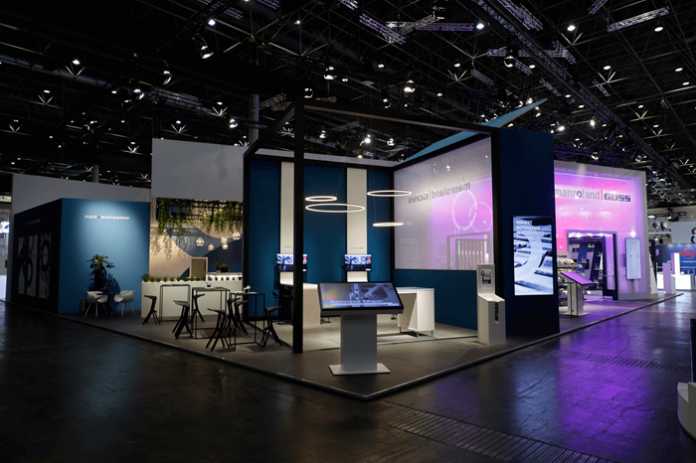At drupa 2024, manroland Goss, a leading provider of web offset printing and digital finishing solutions, showcased its latest innovations, including the industry 4.0 AI-based platform Maintellisense, the Varioman press for packaging printing, and a variable format pin folder for book printing.

Photo- IPP
The company’s stand was a hub of activity as live demonstrations of their products drew significant attention, explained Sudeep Bhattacharjee, managing director of manroland Goss, during an interaction at the company’s Noida office.
Emphasizing the importance of the ‘touch and feel’ concept in exhibitions, Bhattacharjee stated, “Exhibitions are the place where machines should be highlighted rather than showcasing literature. One can go through literature from anywhere, but the physical experience of the machine is only available at exhibitions.”
Though various reports suggested a low attendance at this year’s drupa compared to its previous editions, the manroland Goss team reported positive feedback and a good number of visitors at its stand. The company’s focus on live demonstrations and interactive displays allowed visitors to experience their technology firsthand.
With its expertise in automation for every sector and maintenance using the latest sensors and software, the company showcased the AI-based maintenance platform Maintellisense, which was a key highlight at drupa 2024. It promises to increase productivity in print production and reduce waste of newsprint and other consumables, as well as energy and manpower.
To emphasize the practical benefits of this platform, the team created a small printer machine model, allowing attendees to witness the working model of the AI-based program.
Bhattacharjee explained, “We tried to showcase how easy it is to do condition-based monitoring on your equipment for proper predictive maintenance, and how this can increase efficiency and reduce costs.” The detailed reports generated by the AI program impressed both the legacy printers, who were intrigued by its potential.

Another major highlight was the Varioman press, which comes in three lines — the f-line for printing on films, the c-line for printing on cardboard and paper, and the b-line for book printing. The Varioman press can be equipped with offset, flexo, or gravure units, making it a versatile hybrid press that meets various application demands.
Bhattacharjee noted that the press promises lower production costs and increased productivity, with features such as solvent-free EB curing and minimized ink consumption, positioning it as an environmentally friendly option for the industry.
The flexibility of the Varioman press garnered significant interest among attendees, particularly from commercial and newspaper press owners looking to diversify into the packaging sector. “The Varioman received very good feedback and many inquiries during and after the exhibition,” Bhattacharjee said.
In addition to the Varioman press, manroland Goss introduced a variable format pin folder tailored for the book-printing segment. This technology enables efficient processing of different formats, enhancing flexibility and efficiency even for short runs. The variable format pin folder was designed to meet the specific needs of book printers, providing a solution that adapts to various formats and production requirements.
Newspaper industry and automation
Bhattacharjee, while acknowledging the decline of the newspaper industry during the Covid pandemic, believes it has made a notable comeback, despite losing a segment to digital media. “After the pandemic, the national dailies have realized they have lost a certain section to digital that won’t return. Yet, they have made progress after the downfall as every industry understands the importance and credibility of print. Big companies still advertise in newspapers and in print.”

Bhattacharjee noted that this shift has forced the newspaper industry to become more efficient. He emphasizes that while the industry is doing its best, further progress requires greater automation in various segments.
“Although the newspaper industry has a certain level of automation, further automation will increase its efficiency and reduce costs,” he explained. He stressed that while many factors are beyond their control, managing operations through automation is the key to boosting efficiency.
According to Bhattacharjee, there is a skills gap in every sector, with skilled workers increasingly reluctant to work in factory settings. He argues that automation is essential to make industries more efficient and cost-effective. “Automation can address the shortage of skilled manpower and enhance efficiency in any sector.”












